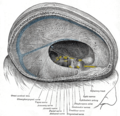Glossopharyngeal nerve: Difference between revisions
From WikiMD's Wellness Encyclopedia
CSV import |
CSV import |
||
| Line 31: | Line 31: | ||
{{stub}} | {{stub}} | ||
<gallery> | |||
File:Gray791.png|Glossopharyngeal nerve | |||
File:Gray793.png|Glossopharyngeal nerve | |||
File:Brain_human_normal_inferior_view_with_labels_en.svg|Glossopharyngeal nerve | |||
File:Gray567.png|Glossopharyngeal nerve | |||
File:Gray719.png|Glossopharyngeal nerve | |||
File:Gray779.png|Glossopharyngeal nerve | |||
File:Gray792.png|Glossopharyngeal nerve | |||
File:Gray794.png|Glossopharyngeal nerve | |||
</gallery> | |||
Latest revision as of 11:32, 18 February 2025
Glossopharyngeal nerve is the ninth cranial nerve (CN IX) in humans. It exits the brainstem out from the sides of the upper medulla, just anterior (closer to the nose) to the vagus nerve. The glossopharyngeal nerve is associated with the tongue and the pharynx.
Anatomy[edit]
The glossopharyngeal nerve is a mixed nerve that carries afferent sensory and efferent motor information. It exits the brainstem out from the sides of the upper medulla, just rostral (closer to the nose) to the vagus nerve.
Function[edit]
The glossopharyngeal nerve has many functions, including:
- It receives general somatic afferent fibers (sensory neurons) from the tonsils, the pharynx, the middle ear and the posterior one-third of the tongue.
- It receives special visceral afferent fibers (sensory neurons) from the posterior one-third of the tongue.
- It receives general visceral afferent fibers (sensory neurons) from the carotid body and the carotid sinus.
- It gives rise to general somatic efferent fibers (motor neurons) to stylopharyngeus muscle.
- It gives rise to general visceral efferent fibers (parasympathetic neurons) to the parotid gland via the otic ganglion.
Clinical significance[edit]
Damage to the glossopharyngeal nerve can result in loss of taste sensation to the posterior one-third of the tongue, and impaired swallowing.










